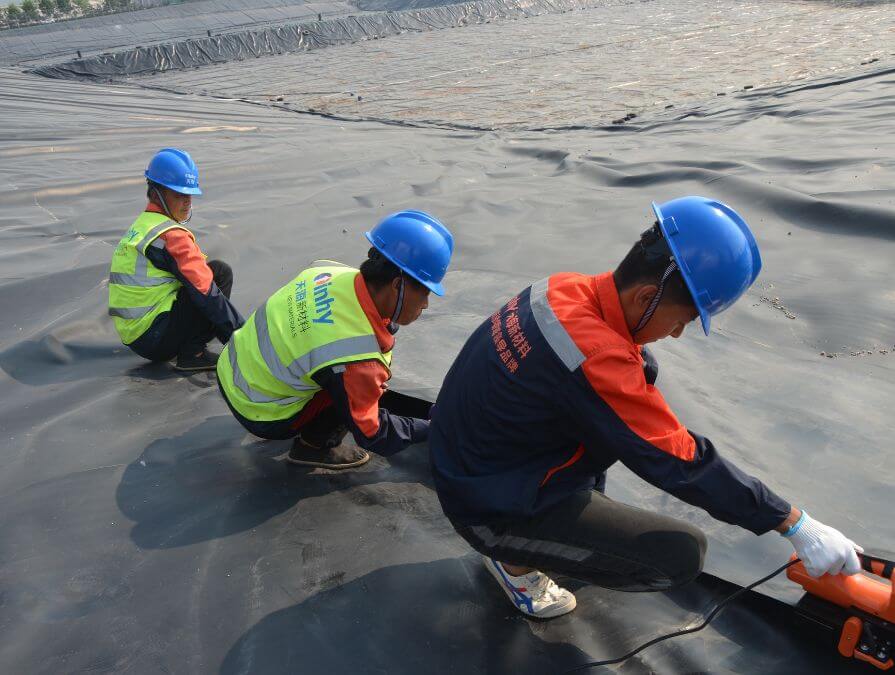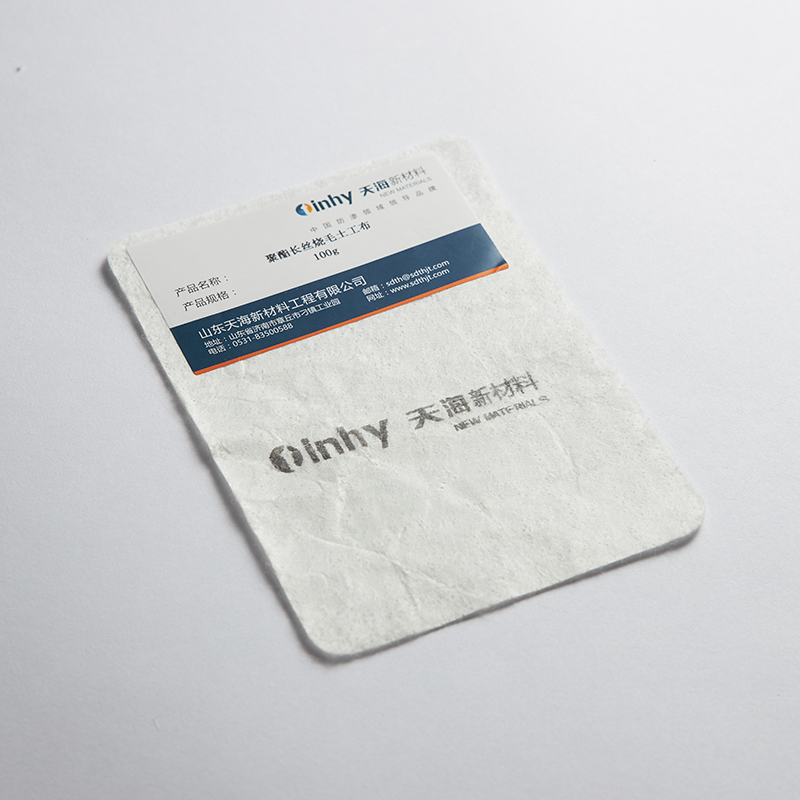9 laying methods of geotextile:
The geotextile roll should be protected from damage before installation and deployment. The geotextile rolls should be stacked in a leveled place without water accumulation, the stack height should not exceed the height of four rolls, and the identification sheet of the roll can be seen.
Geotextile rolls must be covered with an opaque material to protect against UV aging. During the storage process, the integrity of the label and the integrity of the information must be maintained. Geotextile rolls must be protected from damage during transport, including transport from the site where the material is stored to the job site.
Physically damaged geotextile rolls must be repaired. Geotextiles subject to severe wear cannot be used. Any geotextiles exposed to leaked chemical reagents are not allowed to be used in this project.

laying methods of geotextile:
1. Use manual rolling, the cloth surface should be flat, and an appropriate allowance for deformation should be left.What are the performance characteristics of HDPE geomembrane?ion should be left.
2. The installation of long-filament or short-filament geotextiles usually adopts lap joints, stitching and welding. The width of stitching and welding is generally more than 0.1m, and the width of lap joints is generally more than 0.2m. Geotextiles that may be exposed for a long time should be welded or stitched.
3. Sewing of geotextile:
All stitching must be continuous (e.g. spot stitching is not permitted). Geotextiles must overlap a minimum of 150mm before overlapping. The minimum stitch distance from the selvage (the exposed edge of the material) is at least 25mm.
The sewn geotextile seams include 1 row of wired lock chain seams. The thread used for suturing should be a resin material with a minimum tension exceeding 60N, and have chemical resistance and UV resistance comparable to or exceeding that of geotextiles.
Any “missing stitches” in the sewn geotextile must be resewn in the affected area.
Appropriate measures must be taken to prevent soil, particulate matter or foreign matter from entering the geotextile layer after installation.
The overlapping of cloth can be divided into natural overlapping, seaming or welding according to the terrain and use function.
4. During construction, the geotextile above the geomembrane is naturally lapped, and the geotextile on the upper layer of the geomembrane is seamed or hot-air welded. Hot air welding is the preferred connection method for filament geotextiles, that is, use a heat gun to heat the connection of two pieces of cloth at a high temperature instantaneously to make part of it reach a molten state, and immediately use a certain external force to make it firmly bonded together.
In the case of wet (rainy and snowy) weather where thermal bonding is not possible, geotextiles should adopt another method-suture connection method, that is, use a special sewing machine for double-thread suture connection, and use chemical-resistant ultraviolet sutures.
The minimum width is 10cm when suturing, the minimum width is 20cm for natural lap joints, and the minimum width for hot air welding is 20cm.
5. For seams, use sutures with the same quality as geotextiles, and sutures with materials that are more resistant to chemical damage and ultraviolet light.
6. After the geotextile is laid, the geomembrane will be laid after being approved by the on-site supervision engineer.
7. The geotextile on the geomembrane is laid as above after the geomembrane is approved by Party A and the supervisor.
8. The numbers of the geotextiles of each layer are TN and BN.
9. The upper and lower layers of geotextiles on the membrane should be buried in the anchoring groove together with the geomembrane at the part where there is an anchoring groove.
Basic requirements for geotextile laying:
1. The joints must intersect with the slope line; where the slope toe is balanced or there may be stress, the distance between the horizontal joints must be greater than 1.5m.
2. On the slope, anchor one end of the geotextile, and then put the coiled material down on the slope to ensure that the geotextile remains in a tight state.
3. All geotextiles must be pressed with sandbags, which will be used during laying and retained until the laying of the upper layer of material.
Geotextile laying process requirements:
1. Grassroots inspection: check whether the grassroots is smooth and firm, and if there are foreign objects, they should be handled properly.
2. Trial laying: According to the site conditions, determine the size of the geotextile, and try laying after cutting. The cutting size should be accurate.
3. Check whether the width of the sala is appropriate, and the overlapping joints should be flat and moderately tight.
4. Positioning: Use a hot air gun to bond the overlapping parts of the two geotextiles, and the distance between the bonding points should be appropriate.
5. When suturing the overlapping parts, the suture line should be straight and the stitches should be uniform.
6. After sewing, check whether the geotextile is laid flat and whether there are defects.
7. If there is a phenomenon that does not meet the requirements, it should be repaired in time.

Self-inspection and repair of geotextiles:
a. All geotextiles and seams must be checked. Defective geotextile pieces and stitches must be clearly marked on the geotextile and repaired.
b. Worn geotextiles must be repaired by laying and thermally joining small pieces of geotextiles which are at least 200mm longer in all directions than the edge of the defect. The thermal connection must be strictly controlled to ensure that the geotextile patch and the geotextile are tightly bonded and there is no damage to the geotextile.
c. Before the end of laying every day, visually inspect the surface of all geotextiles laid that day to make sure that all damaged places have been marked and repaired immediately, and make sure that there are no foreign substances that may cause damage on the laid surface, such as fine needles, small iron Nails etc.
d. The following technical requirements should be met when the geotextile is damaged and repaired:
e. The patch material used to fill holes or fill cracks should be consistent with geotextiles.
f. The patch should extend at least 30 cm outside the damaged geotextile.
g. At the bottom of the landfill, if the crack of the geotextile exceeds 10% of the width of the coil, the damaged part must be cut off, and then the two geotextiles are connected; if the crack exceeds 10% of the width of the coil on the slope, the crack must be Remove the geotextile roll and replace it with a new one.
h. The work shoes worn by the construction personnel and the construction equipment used should not damage the geotextile. The construction personnel are not allowed to do things that may damage the geotextile on the laid geotextile, such as smoking or poking the geotextile with sharp tools.
i. For the safety of geotextile materials, the packaging film should be opened before laying geotextiles, that is, one roll is laid and one roll is opened. And check the appearance quality.
j. In particular: after the geotextile arrives at the site, it must be inspected and approved in time.
Strictly implement the company’s “Geotextile Construction and Acceptance Regulations”

[wpforms id=”40″]


